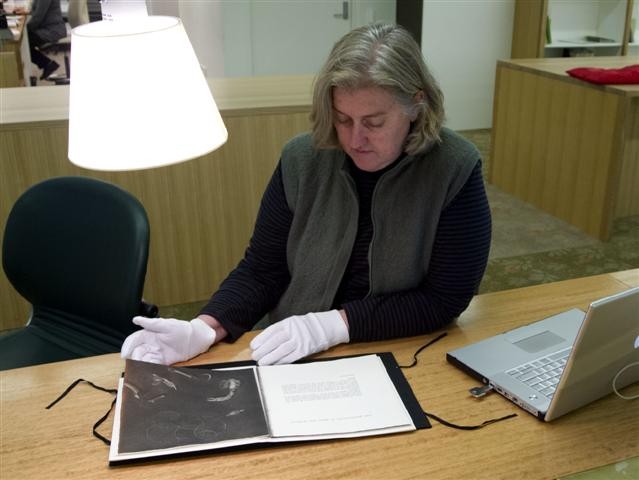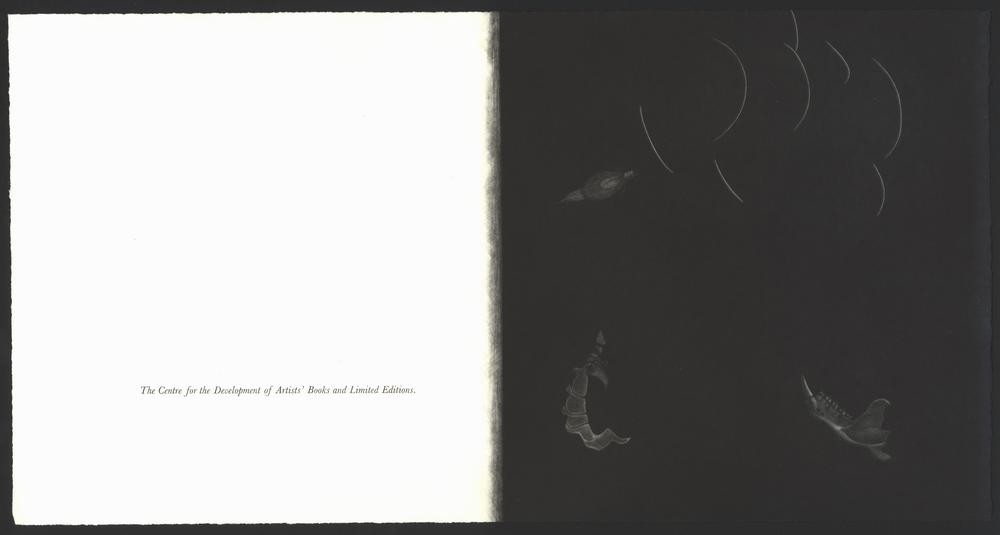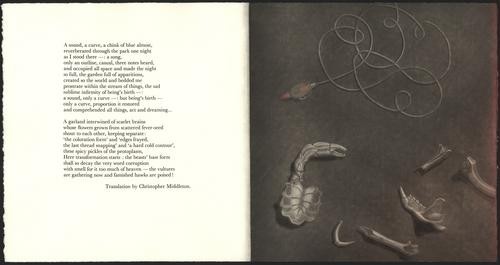This is the first of our guest blogs in which photographer and bookmaker Victoria Cooper gives us her impressions of Monologues, a book of mezzotints by Graeme Peebles with a text by Gottfried Benn.
Images of all pages of the book are available through the Onesearch catalogue.

- the site of the book,
- my physical interaction with it,
- the appearance of the skill in the production of the object, and
- my life stories along with those of the book artist and writer.
The book, Monologues, essentially contains a poem by Gottfried Benn (1886-1956), and mezzotints by Graeme Peebles (1955-). But there are also other contributing parties: concept and design by Petr Herel (1943-), the English translation from Benn’s German text by Christopher Middleton (1926-), the master printer, Bill Young (King Valley Studio, Victoria), the typography composed by Thierry Bouchard in Losne, France and printed by Les Petersen, the box maker and so on. All of these internal actants influence my reading/viewing of the book. The external environment also contributes to a reading experience.
For me, books are most powerful close to their referential site. Here the environment and activity (both sensorial and intellectual) enable a time/space continuum conducive to the reading. I consider the reading of Monologues at the stage of printing with the smell of ink and paper, what then would I experience? Would the reading of this book be influenced by the external sensations of the print studio, its materials and process?
It should also be noted that this book is available for viewing via computer screen, presenting an entirely different modality of reading. The computer screen deactivates much of the sensorial and object-ness created by the artist and artisan contributors. Then there is the gallery vitrine where the book becomes symbolic but unreadable. This then leaves only one site, for me, where the book can be read—the Library.

I am in the site of the Library’s quiet and reflective space. I physically and spatially discern the book. It is an object to be touched, its textural qualities to be contemplated as part of this site’s reverence for the book. As I read the images in Monologues, I seek visual metaphors and elements of change—the development and contrasting of ideas.
The artist, Peebles, supervises the application of colour and tone through multiple printings of two plates. This visual poet intellectualizes objects as symbols and signs floating in a grey foggy darkness that subtly changes with colour and tone and detail. For me, the subtle inclusions of colour, the quiet sharpness of the visual metaphors, the cross-section of a cut apple, ‘speak’ a silent poem of life and death.
Benn’s poem is confronting, strong and emotional, transporting me to a darker place. To read the poem is to engage in a battle or a rage - something to feel rather than see. I return again and again, I am left reeling—as from the unforseen suicide of a friend committed without a parting note.
As explained in the library catalogue notes, both the artist and the poet were purposely uninformed in this unlikely posthumous (well after the death of Gottfried Benn) collaboration. But Herel has presented this as a conceptual work where inevitably the images connect the words in the readers mind. In my many readings, both in the Library and on the screen, I found the following words reverberate across both Monologues, at a point where the prints and the poem work in synchronicity.

“To die means leaving all these things unsolved,
the images unsure, and the hungry dreams
abandoned in the rifts between the worlds — . . .”
As a reader, the visual poetic metaphors in Monologues connect me with the unresolvable and the abandoned—where like finding a lost treasure I am rewarded by new insights and layers into my own potential for reading.
Victoria Cooper
Comments
Your email address will not be published.
We welcome relevant, respectful comments.